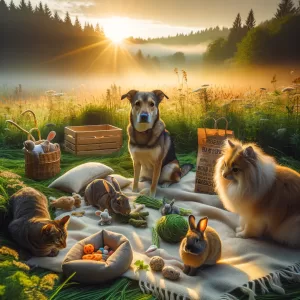Parrots, known for their vibrant plumage and impressive mimicry skills, are among the most popular pets worldwide. Yet, their allure goes far beyond their aesthetic appeal and their ability to replicate human speech. Inherently social creatures, parrots form complex relationships both with their own kind and with their human caregivers. This blog post delves into the fascinating social nature of parrots, exploring their social structures, the bonds they form with humans, and the emotional implications of these relationships.
Chapter 1: The Flock Mentality: Understanding the Social Dynamics of Parrots in the Wild
Parrots are widely known for their vibrant colors and ability to mimic human speech. However, beneath these well-known characteristics lies a complex social structure that is often overlooked. In the wild, parrots live in large flocks, engaging in cooperative behaviors that play a crucial role in their survival and well-being. This post explores the intricate ‘flock mentality’ of parrots, their roles within the group, their communication methods, and the emotional implications of this social interaction.
Cooperative Behaviors in Parrot Flocks:
The social structure of parrot flocks is rooted in cooperative behaviors that benefit the group as a whole. These behaviors include communal roosting, where parrots gather in large groups to sleep at night, providing safety in numbers from predators. Foraging is another shared activity, where parrots search for food collectively, reducing the risk of predation and increasing efficiency. Even the task of raising offspring is a shared responsibility, with group members often helping to feed and care for the young.
Each Parrot Has a Role:
Within the parrot flock, every bird has a role. Some birds serve as lookouts, alerting the group to the presence of predators. Others may be responsible for finding food or caring for the young. These roles are fluid and can change based on the needs of the group. This level of cooperation and division of labor is a testament to the social intelligence of these birds.
Communication in Parrot Flocks:
Parrots communicate using a sophisticated array of vocal and visual signals. Vocalizations, such as squawks and calls, can communicate everything from the location of a food source to the presence of a threat. Visual signals, such as body language and feather positioning, can convey a parrot’s emotional state or intent. This complex communication system allows parrots to coordinate their activities and maintain social bonds within the flock.
The Emotional Implications of Flock Mentality:
The social interaction inherent in the flock mentality is not just about survival. It also plays a significant role in a parrot’s emotional well-being. Parrots are highly social creatures, and isolation can lead to negative emotional states such as loneliness and depression. This mirrors the emotions seen in social mammals, highlighting the emotional depth and complexity of these birds.
__
The flock mentality of parrots is a fascinating aspect of their behavior, revealing a complex social structure and emotional depth that is often underestimated. Their cooperative behaviors, role dynamics, sophisticated communication, and emotional well-being are all intertwined within this social framework. As we continue to study and understand these behaviors, we gain a deeper appreciation for parrots not just as colorful, mimicking birds, but as intelligent, social beings with complex emotional lives. This understanding can also guide how we care for parrots in captivity, ensuring that we meet their social and emotional needs and promote their overall well-being. Indeed, the social world of parrots is as vibrant and complex as their beautiful plumage.








